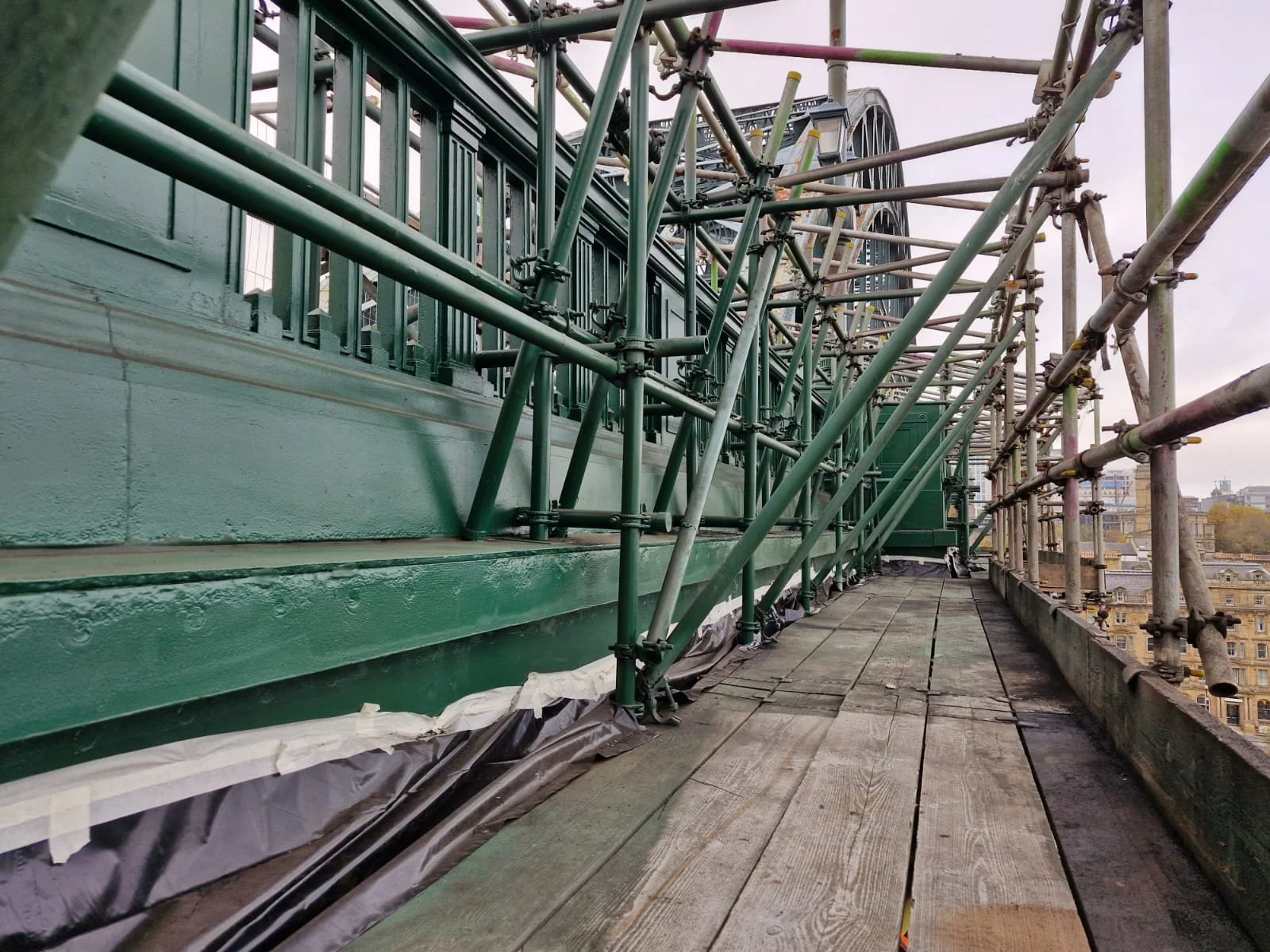New paint revealed as scaffolding dismantled on the Tyne Bridge
Passersby on the Tyne Bridge can see for themselves the new shiny ‘Hollybush’ green coat of paint on the Tyne Bridge as the scaffold starts to be dismantled around the Gateshead Tower, revealing the major restoration work that has been taking place over the last six months.
The first completed section of blasted, repaired and re-painted steel can be seen on the Gateshead side of the bridge.
Starting at deck level around the bridge parapet, teams are dismantling the scaffold and kittiwake hotels as this first section of work adjacent to the Gateshead Tower is completed. To carry out this work safely, there will be three overnight closures of the Tyne Bridge from 8pm to 6am on the 4 to 6 November. At the same time, new temporary lighting will be installed as the historic lighting columns are to be repaired as part of the restoration works. The bridge will remain open for people walking and cycling during these closures.
The scaffolding will be dismantled level by level later this year with a view to being completed before the kittiwakes return next year for their breeding season. As this work progresses people will be able to see more of the major transformation which has been taking place behind the encapsulation.
As the scaffold comes down on the Gateshead side, it will gradually rise on the Newcastle side, so the scaffolding is fully in place to allow restoration work to begin adjacent to the Newcastle tower in early 2025. As with the Gateshead tower works, this will be fully encapsulated before teams begin the mammoth task of cleaning, grit blasting and steelwork repairs before the final stages of painting can take place. Works adjacent to the Newcastle tower is scheduled to be completed by Autumn 2025, before moving on to the main bridge arch.
Cllr Juna Sathian, cabinet member for Climate and Transport at Newcastle City Council said: “This is a hugely complex and challenging project and it’s great that people can now see for themselves the results of the restoration work, which has been taking place for many months behind the scaffolding.
“There is a real sense of passion and pride from everyone involved in the restoration programme as we proudly restore this icon to its former glory. This first glimpse gives us an idea of how amazing our much-loved bridge will look when the restoration programme is complete, and I can’t wait to see the end result.”
As restoration progresses around both towers, operatives have also been working within the service void on the main bridge deck, which is just 1.5 metres high in places. The void is packed with service ducts, cables and two cast iron mains which carry gas and water, as well as the main bridge girders and hangers, making working conditions very cramped and difficult.
So far, several sections of heavily corroded steelwork have been replaced and major repairs are being undertaken to three of the deck hangers where they connect to the main cross beams. Rust and scale are now being removed in preparation for the surface to be repainted.




Due to its Grade II* listed status, the paint colour being used is a British Standard 4800 colour referenced 14C39 called ‘Hollybush’. This is as close to the original colour as possible.
The new paint system has been chosen for its durability, UV resistance, protective and colour retention qualities, and its resistance to the harsh atmospheric environment of the bridge, sitting above a tidal river and subject to the winds of the Tyne Valley gorge. It should give protection to the bridge for the next 30 years before major repainting is required.
Thorough investigations have outlined that more than 1,000 repairs need to be carried out to preserve the landmark for future generations, this involves steel, concrete, stonework and masonry repairs, drainage improvements, bridge deck waterproofing, resurfacing, parapet protection and bridge joint replacement, as well as a full paint job.
Over the four-year £32 million programme, various sections of the iconic structure will be clad in scaffolding as work progresses which means passers-by won't be able to see what is happening until the scaffold is removed.
To deliver the repairs and strengthening safely, the scaffold will be installed over approximately 20 phases to maintain the integrity of the structure’s load capacity, while keeping the road and footpaths open to traffic and pedestrians throughout the project. These loading constraints result in the programme to complete the restoration being across four years.
Esh Construction is carrying out the restoration on behalf of Newcastle and Gateshead Councils.
The four-year programme is expected to be complete in Summer 2028, ahead of the bridge’s centenary in October 2028.
The Tyne Bridge restoration is funded by the UK Government, as well as monies from both Newcastle City Council and Gateshead Council.

